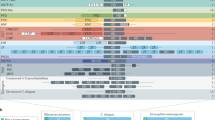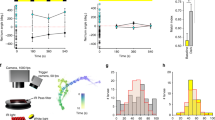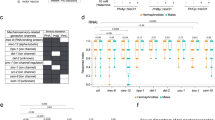Abstract
How left/right functional asymmetry is layered on top of an anatomically symmetrical nervous system is poorly understood. In the nematode Caenorhabditis elegans, two morphologically bilateral taste receptor neurons, ASE left (ASEL) and ASE right (ASER), display a left/right asymmetrical expression pattern of putative chemoreceptor genes that correlates with a diversification of chemosensory specificities1,2. Here we show that a previously undefined microRNA termed lsy-6 controls this neuronal left/right asymmetry of chemosensory receptor expression. lsy-6 mutants that we retrieved from a genetic screen for defects in neuronal left/right asymmetry display a loss of the ASEL-specific chemoreceptor expression profile with a concomitant gain of the ASER-specific profile. A lsy-6 reporter gene construct is expressed in less than ten neurons including ASEL, but not ASER. lsy-6 exerts its effects on ASEL through repression of cog-1, an Nkx-type homeobox gene, which contains a lsy-6 complementary site in its 3′ untranslated region and that has been shown to control ASE-specific chemoreceptor expression profiles3. lsy-6 is the first microRNA to our knowledge with a role in neuronal patterning, providing new insights into left/right axis formation.
This is a preview of subscription content, access via your institution
Access options
Subscribe to this journal
Receive 51 print issues and online access
$199.00 per year
only $3.90 per issue
Buy this article
- Purchase on Springer Link
- Instant access to full article PDF
Prices may be subject to local taxes which are calculated during checkout




Similar content being viewed by others
References
Yu, S., Avery, L., Baude, E. & Garbers, D. L. Guanylyl cyclase expression in specific sensory neurons: a new family of chemosensory receptors. Proc. Natl Acad. Sci. USA 94, 3384–3387 (1997)
Pierce-Shimomura, J. T., Faumont, S., Gaston, M. R., Pearson, B. J. & Lockery, S. R. The homeobox gene lim-6 is required for distinct chemosensory representations in C. elegans. Nature 410, 694–698 (2001)
Chang, S., Johnston, R. J. Jr & Hobert, O. A transcriptional regulatory cascade that controls left/right asymmetry in chemosensory neurons of C. elegans. Genes Dev. 17, 2123–2137 (2003)
Halpern, M. E., Liang, J. O. & Gamse, J. T. Leaning to the left: laterality in the zebrafish forebrain. Trends Neurosci. 26, 308–313 (2003)
Yost, H. J. Left-right development from embryos to brains. Dev. Genet. 23, 159–163 (1998)
Hobert, O., Johnston, R. J. Jr & Chang, S. Left-right asymmetry in the nervous system: the Caenorhabditis elegans model. Nature Rev. Neurosci. 3, 629–640 (2002)
Bargmann, C. I. & Horvitz, H. R. Chemosensory neurons with overlapping functions direct chemotaxis to multiple chemicals in C. elegans. Neuron 7, 729–742 (1991)
White, J. G., Southgate, E., Thomson, J. N. & Brenner, S. The structure of the nervous system of the nematode Caenorhabditis elegans. Phil. Trans. R. Soc. Lond. B 314, 1–340 (1986)
Hobert, O., Tessmar, K. & Ruvkun, G. The Caenorhabditis elegans lim-6 LIM homeobox gene regulates neurite outgrowth and function of particular GABAergic neurons. Development 126, 1547–1562 (1999)
Troemel, E. R., Sagasti, A. & Bargmann, C. I. Lateral signaling mediated by axon contact and calcium entry regulates asymmetric odorant receptor expression in C. elegans. Cell 99, 387–398 (1999)
Wicks, S. R., Yeh, R. T., Gish, W. R., Waterston, R. H. & Plasterk, R. H. Rapid gene mapping in Caenorhabditis elegans using a high density polymorphism map. Nature Genet. 28, 160–164 (2001)
Lee, R. C., Feinbaum, R. L. & Ambros, V. The C. elegans heterochronic gene lin-4 encodes small RNAs with antisense complementarity to lin-14. Cell 75, 843–854 (1993)
Olsen, P. H. & Ambros, V. The lin-4 regulatory RNA controls developmental timing in Caenorhabditis elegans by blocking LIN-14 protein synthesis after the initiation of translation. Dev. Biol. 216, 671–680 (1999)
Ambros, V., Lee, R. C., Lavanway, A., Williams, P. T. & Jewell, D. MicroRNAs and other tiny endogenous RNAs in C. elegans. Curr. Biol. 13, 807–818 (2003)
Lim, L. P. et al. The microRNAs of Caenorhabditis elegans. Genes Dev. 17, 991–1008 (2003)
Grad, Y. et al. Computational and experimental identification of C. elegans microRNAs. Mol. Cell 11, 1253–1263 (2003)
Lau, N. C., Lim, L. P., Weinstein, E. G. & Bartel, D. P. An abundant class of tiny RNAs with probable regulatory roles in Caenorhabditis elegans. Science 294, 858–862 (2001)
Johnson, S. M., Lin, S. Y. & Slack, F. J. The time of appearance of the C. elegans let-7 microRNA is transcriptionally controlled utilizing a temporal regulatory element in its promoter. Dev. Biol. 259, 364–379 (2003)
Lanjuin, A., VanHoven, M. K., Bargmann, C. I., Thompson, J. K. & Sengupta, P. Otx/otd homeobox genes specify distinct sensory neuron identities in C. elegans. Dev. Cell 5, 621–633 (2003)
Stark, A., Brennecke, J., Russell, R. B. & Cohen, S. M. Identification of Drosphila MicroRNA targets. PLOS Biol. Online publication 13 October 2003 (doi:10.1371/journal.pbio.0000060)
Palmer, R. E., Inoue, T., Sherwood, D. R., Jiang, L. I. & Sternberg, P. W. Caenorhabditis elegans cog-1 locus encodes GTX/Nkx6.1 homeodomain proteins and regulates multiple aspects of reproductive system development. Dev. Biol. 252, 202–213 (2002)
Hobert, O. PCR fusion-based approach to create reporter gene constructs for expression analysis in transgenic C. elegans. Biotechniques 32, 728–730 (2002)
Acknowledgements
We are grateful to A. Wenick and B. Reinhart for suggestions; Q. Chen for technical assistance; R. Mann, L. Johnston, P. Sengupta and A. Lanjuin for critically reading the manuscript; and the NSF (R.J.J.) and NIH (O.H.) for funding.
Author information
Authors and Affiliations
Corresponding author
Ethics declarations
Competing interests
The authors declare that they have no competing financial interests.
Supplementary information
41586_2003_BFnature02255_MOESM1_ESM.doc
Supplementary Information: Experimental procedures and quantification of defects described in the figures in the main paper and list of constructs and primers used (DOC 40 kb)
Rights and permissions
About this article
Cite this article
Johnston, R., Hobert, O. A microRNA controlling left/right neuronal asymmetry in Caenorhabditis elegans. Nature 426, 845–849 (2003). https://doi.org/10.1038/nature02255
Received:
Accepted:
Published:
Issue Date:
DOI: https://doi.org/10.1038/nature02255
This article is cited by
-
Evolution of central neural circuits: state of the art and perspectives
Nature Reviews Neuroscience (2022)
-
Functional identification of microRNA-centered complexes in C. elegans
Scientific Reports (2022)
-
Cell-type-specific profiling of loaded miRNAs from Caenorhabditis elegans reveals spatial and temporal flexibility in Argonaute loading
Nature Communications (2021)
-
Plasticity in gustatory and nociceptive neurons controls decision making in C. elegans salt navigation
Communications Biology (2021)
-
Differential expression of microRNAs in the human fetal left and right cerebral cortex
Molecular Biology Reports (2020)
Comments
By submitting a comment you agree to abide by our Terms and Community Guidelines. If you find something abusive or that does not comply with our terms or guidelines please flag it as inappropriate.



